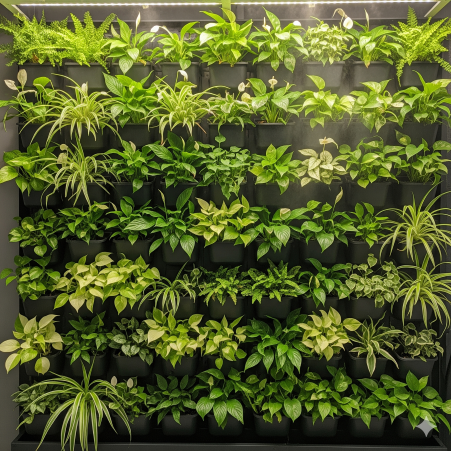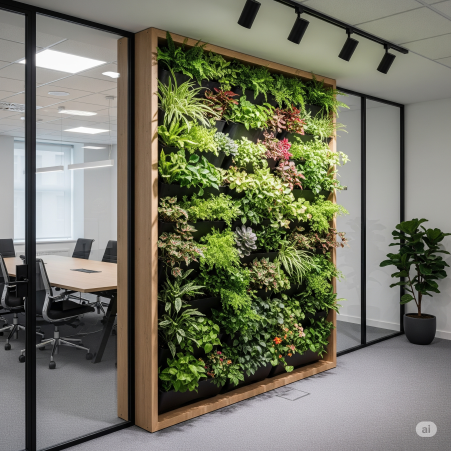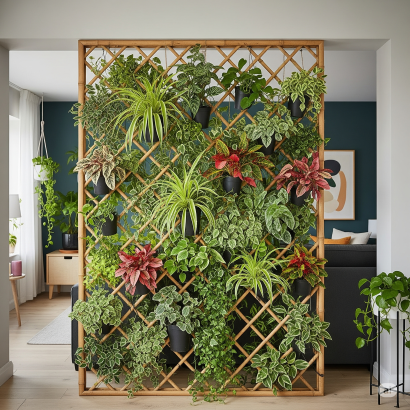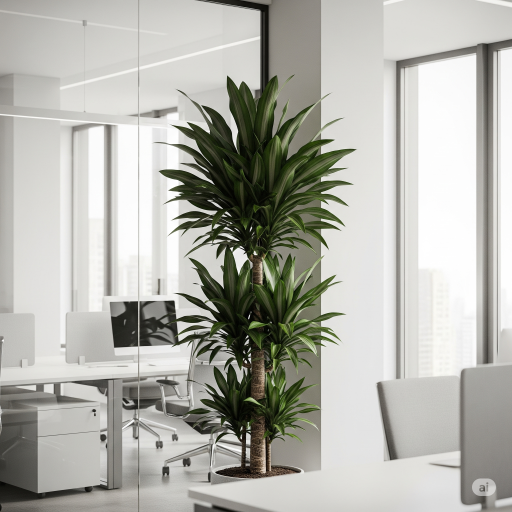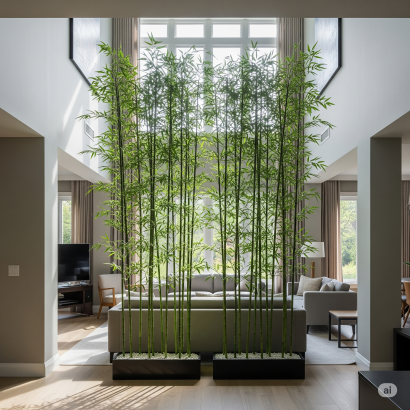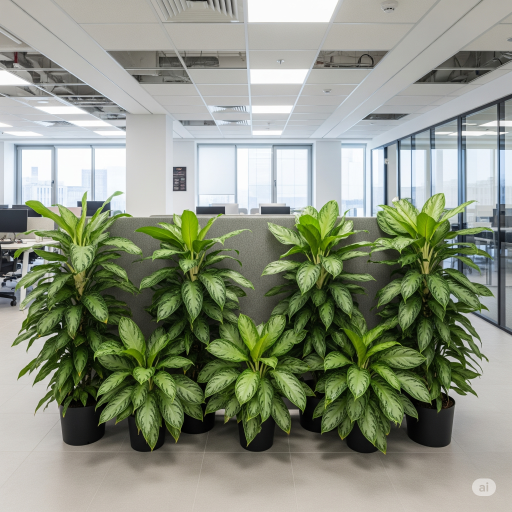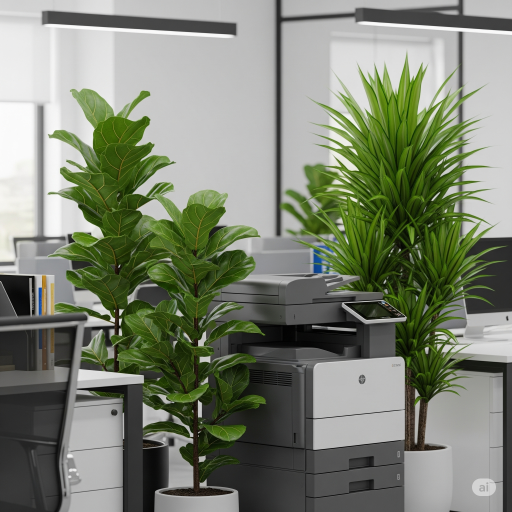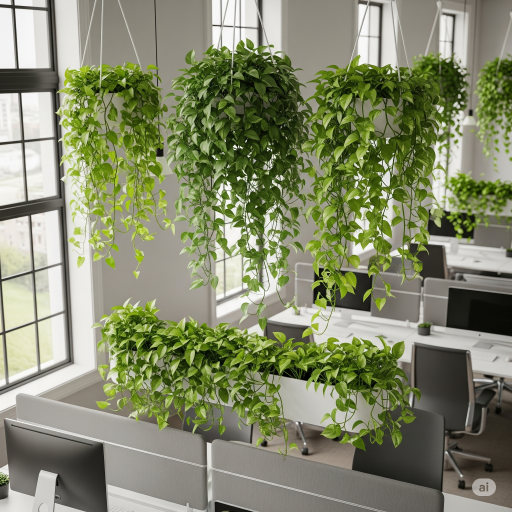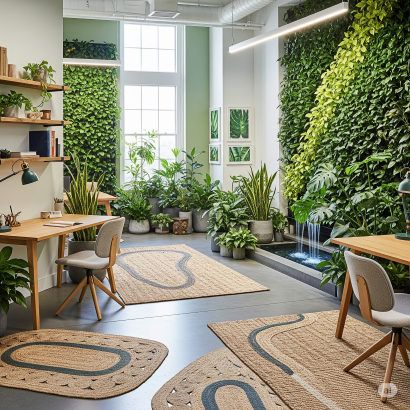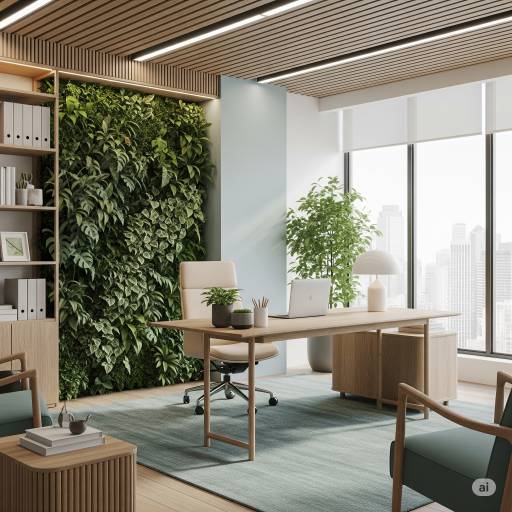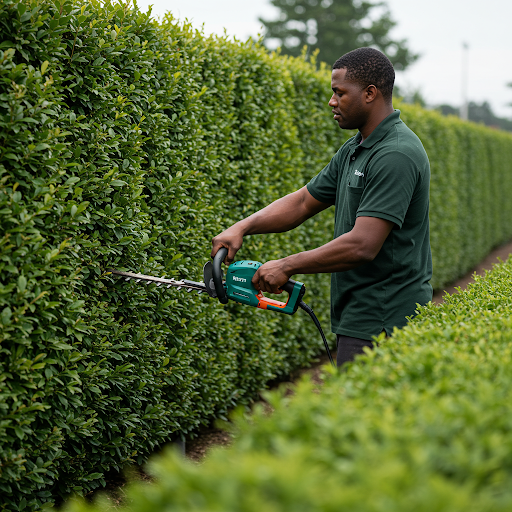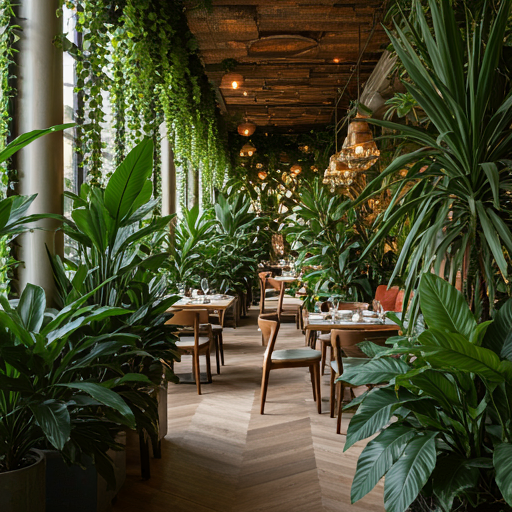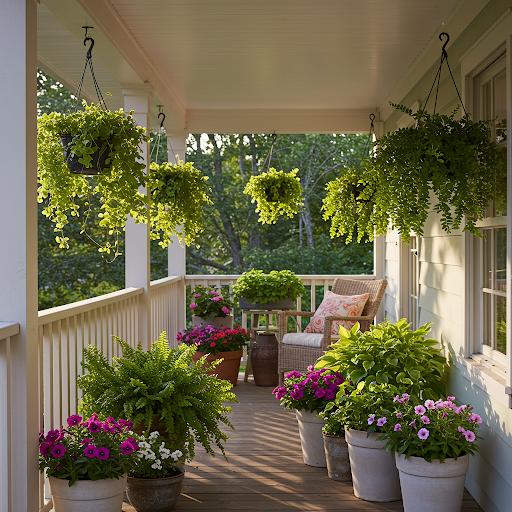Description
Soundproofing with Nature: Acoustic Plant-Scaping
Acoustic Plant-Scaping is a key component of modern office biophilic design. It moves plants beyond simple decoration and integrates them as functional, acoustic, and aesthetic solutions.
Acoustic Plants-Scaping, also known as acoustic biophilia or soundscaping with nature, is the deliberate and strategic use of living plants, green walls, and moss art to naturally manage and improve the acoustic environment within a space.
It integrates principles of horticulture and acoustics to create aesthetically pleasing landscapes that simultaneously reduce unwanted noise, primarily by managing reverberation and echo.
The Science of Sound Mitigation by Plants
Plants alone can’t achieve the high level of sound blocking that dense walls or engineered barriers can. But their ability to manage existing sound through these three mechanisms—absorption, diffusion, and masking—is highly effective for improving office interior acoustic comfort and reducing echo.
1. Absorption (The Acoustic Sponge)
Absorption is the process where sound energy is taken in by a material and converted into other forms of energy, primarily a small amount of heat, rather than being reflected. This reduces the overall noise level and shortens the reverberation time (the time it takes for sound to decay).
Mechanism
Plant tissues, particularly leaves, stems, and rough bark, behave as porous, soft materials. When a sound wave hits these surfaces, the air vibrating within the small pores, cracks, and intercellular spaces loses energy due to friction (viscous losses).
Key Contributing Elements
Leaves
Leaves function as natural acoustic dampeners. Large, thick, or fleshy leaves (like those of the Rubber Plant or Fiddle-Leaf Fig), and dense clusters of foliage, are most effective. When a sound wave strikes them, the air vibrating within the small pores (stomata) and the irregular cell structure of the leaf tissue, looses energy due to friction. This mechanism is particularly effective at absorbing mid-to-high frequencies. Around $500 \text{ Hz}$ to $2000 \text{ Hz}$, which includes the crucial range of human speech. This significantly improves communication clarity in offices.
Substrate/Soil
In potted plants, especially in large living green walls, the soil or growing substrate is a vital acoustic component. This material, typically a mix of porous organic matter and minerals, acts structurally like a porous acoustic foam. The countless air voids and capillaries within the substrate provide a large surface area where sound waves penetrate. The vibrating air loses energy through viscous losses as it moves through this resistance, leading to significant sound absorption. This is particularly efficient for higher frequencies (above $1000 \text{ Hz}$).
Moss/Bark
Rough, spongy surfaces, such as preserved reindeer moss used in zero-maintenance acoustic walls or the thick, deeply grooved bark of certain trees, are highly valued for their absorption properties. Their irregular texture and extensive porosity dramatically increase the effective surface area that sound waves can encounter. This complex structure causes sound to penetrate and become trapped and dissipated within the natural voids, making materials like moss walls an exceptionally effective and aesthetically pleasing solution for reducing reverberation in modern, hard-surfaced office environments.
2. Diffusion / Scattering (The Wave Breaker)
Diffusion (or scattering) is the process where sound waves are broken up and redirected in multiple directions upon impact, preventing the formation of strong, coherent reflections (echoes).
Mechanism
Sound travels in organized waves. When these waves encounter the complex, non-uniform, and irregular shapes of a dense plant arrangement—stems, branches, leaves of varying sizes, and the overall volume of the plant—the waves are deflected and scattered.
Key Contributing Elements
Complex Structure
A multi-layered arrangement of plants—mimicking the density of a natural ecosystem with different heights and textures—creates a highly effective, irregular barrier for sound. By incorporating groundcover (low planters), shrubs (medium-height plants), and trees (tall focal points), the sound waves are forced to interact with multiple layers of surfaces. This density and complexity scatter the waves extensively, ensuring that no single, clean path is available for sound to travel directly or to reflect back as a sharp echo, thus promoting uniform sound decay.
Foliage Density
The density of the foliage is crucial; it prevents sound from passing directly through the plant arrangement. The close spacing of leaves and stems forces the traveling sound waves to interact repeatedly with numerous different surfaces within the plant’s volume. Each interaction causes a portion of the wave to be absorbed and the remainder to be scattered. A dense planting effectively acts as a turbulent medium for sound, reducing its intensity and cohesiveness, which is essential for minimizing noise bleed between work areas.
Irregular Shapes
Irregular shapes—such as leaves with varied sizes, uneven textures, or vines trailing across a wall—create a non-uniform surface that significantly aids in diffraction (the bending of sound waves around objects) and scattering. Unlike a flat, hard wall that reflects sound waves back in a single, predictable direction (a harsh echo), the random angles and surfaces of a plant diffuse the sound energy. This randomizes the sound field in the room, making the overall acoustic environment much softer, less fatiguing, and far more pleasant for occupants.
3. Masking (The Perception Shifter)
Masking is a psychological process where one sound event, the “masker,” makes the perception of another sound, the “masked,” more difficult or impossible. In acoustic plant-scaping, this isn’t about physical sound blocking, but about shifting perception. The goal is to introduce desirable natural sounds that are pleasant and continuous, thereby diverting attention from and effectively covering up intrusive, annoying, or distracting noises like traffic rumble, loud office chatter, or the hum of HVAC systems. This improves occupant comfort without requiring major structural changes.
Mechanism
Plants are integral to introducing desirable, natural sounds—a form of acoustic camouflage—into the environment. These pleasant, random, and continuous sounds effectively mask or cover up the unpleasant, distracting, or intrusive sounds (like traffic noise, intermittent office chatter, or HVAC hum). Instead of hearing distinct, irritating human noises, the brain focuses on the gentle, natural sounds. This masking doesn’t reduce the physical volume of the distracting noise but significantly reduces its perceived annoyance and its ability to disrupt concentration, especially important for focus work.
Key Contributing Elements
Rustling
Plants with thin, large, or papery leaves (such as certain types of indoor bamboo or slender-leaved Dracaena) create a soft, random, “white noise” sound when moved by even slight air currents from ventilation or natural breezes. This subtle, natural rustling acts as a consistent acoustic veil. Because the sound is non-specific and gentle, the brain perceives it as non-threatening and easily fades it into the background, effectively masking the sharper, more intelligible peaks of surrounding noises like distant conversations.
Associated Features
The inclusion of a water feature (like a small fountain, bubble wall, or stream) in the plant-scaping design is a common and highly effective technique to enhance masking. Water features introduce a continuous, broadband, and pleasant sound that is easily recognizable and soothing. This consistent sound effectively covers speech and other distracting noises without needing to raise the overall sound level excessively. The combination of lush greenery and the sound of trickling water significantly enhances the perceived tranquility of the space.
Psychological Effect
Even where the actual physical decibel reduction achieved by plants is minimal, the psychological effect is profound. The presence of lush, living plants—a visual cue of nature—creates audio-visual congruency with the soothing sounds of the plant-scape (rustling, water). This natural pairing leads occupants to perceive the remaining noise as less annoying and intrusive. The mere sight of the greenery shifts the emotional context of the ambient noise, making the environment feel subjectively quieter, calmer, and more conducive to focus and relaxation.
Key Applications of Acoustic Plant-Scaping
Acoustic plants-scaping is most effective in spaces with hard, reflective surfaces (like glass, concrete, and high ceilings), which are common in contemporary architecture.
1. Corporate & Office Environments
Open-Plan Offices
In open-plan settings, plants act as natural, visually appealing dividers that enhance acoustic comfort. Large, dense plants (e.g., Rubber Plants, various Palms) placed in robust planters absorb high-frequency noise. These include office chatter, keyboard clicks, and phone ringtones. This strategic placement breaks up sound waves and prevents them from traveling far across the room. Thus significantly improves concentration and establishes a subtle, natural sense of visual and auditory privacy between workstations.
Meeting Rooms & Lobbies
Living green walls and preserved moss walls are installed on bare, reflective surfaces like concrete or glass to significantly reduce echo (reverberation). The porous structure of the foliage and the growing medium, or the moss itself, dampens sound energy, stopping it from bouncing back cleanly. This directly improves speech intelligibility during crucial conversations, video calls, and phone conferences. Thus making communication clearer and the overall lobby environment feel calmer and more professional.
Quiet Zones/Focus Pods
Clusters of tall, dense foliage and multi-layered plant arrangements are used to create localized, semi-enclosed “pockets of quiet.” While not fully soundproof, the grouped plants absorb ambient sound coming from the rest of the open office, providing a noticeable reduction in background noise. This allows employees to concentrate more effectively without being completely isolated, offering a crucial intermediate workspace for focused tasks and quick, private conversations.
2. Retail, Hospitality & Healthcare Acoustic Plant-Scaping
Acoustic plant-scaping extends its benefits beyond corporate spaces into public-facing environments where ambiance, comfort, and patient well-being are critical.
Restaurants & Cafés
These hospitality areas notoriously suffer from high noise levels due to hard flooring, communal tables, and customer chatter, leading to a loud, fatiguing environment. Strategically placed, dense plants and acoustic ceiling gardens are employed to absorb high-frequency sounds, effectively dampening the clatter of dishware, loud conversation echo, and background music. By reducing reverberation time, plant-scaping creates a perceptibly more relaxed and intimate dining or social experience, encouraging longer stays and repeat business, which directly impacts the venue’s profitability.
Hotels & Atriums
Hotel environments, particularly those with expansive, multi-story atriums, often struggle with a pronounced, booming echo due to their immense scale and hard surfaces. Large-scale, towering plant installations and cascading green walls act as massive, highly effective sound absorbers, significantly reducing this reverberation. The planting simultaneously provides sophisticated aesthetic appeal, enhances the welcoming atmosphere, and contributes to better indoor air quality, transforming what could be a cold, noisy void into a calming and visually stunning central gathering space for guests.
Hospitals & Clinics
In healthcare settings, the primary goal is to create calming environments that aid healing and reduce anxiety. Greenery is utilized to soothe patients and staff, and the added acoustic benefits are vital. Plants installed in waiting rooms, corridors, and even patient areas absorb the institutional sounds of foot traffic, medical equipment, and staff conversations. This dampening effect contributes to a quieter, less stressful atmosphere, supporting patient recovery and providing staff with a calmer environment to focus on their critical tasks.
3. Residential & Outdoor Acoustic Plant-Scaping
Apartment Balconies & Patios
Dense hedges, vertical gardens, and layered planting are used to create green noise barriers against traffic or neighborhood sounds.
Soundscape Gardens (Outdoor)
Near highways or busy streets, wide belts of dense, layered vegetation (trees, shrubs, groundcover) are designed to absorb and scatter external noise pollution before it reaches the property.
Benefits and Challenges of Acoustic Plant-Scaping
Acoustic Plant-Scaping offers multifaceted benefits. But designers must also be aware of its limitations.
Benefits of Acoustic Plant-Scaping
The advantages of integrating plants for acoustic purposes go well beyond simple sound management:
Acoustic Comfort
The fibrous structure of foliage and the porous nature of the soil media effectively reduce echo and reverberation time by absorbing sound waves. This creates a perceptibly “softer” auditory environment that is more pleasant and less fatiguing. By reducing reverberation, the clarity of speech is enhanced, making communication easier, especially in high-ceilinged or open-plan areas.
Biophilic Design
Integrating living greenery fulfills the innate human need to connect with nature. This connection is scientifically proven to yield measurable physiological benefits. These include reducing stress, leading to lower blood pressure, and improving overall mood and well-being among building occupants. This dual acoustic and biophilic benefit provides a high return on investment in employee health.
Air Quality
Plants contribute to a healthier indoor environment by acting as natural air filters. They reduce airborne toxins, specifically Volatile Organic Compounds (VOCs) like formaldehyde and benzene, which off-gas from furniture and building materials. Furthermore, they naturally increase humidity within typically dry, air-conditioned buildings, benefiting respiratory health and comfort.
Aesthetics and Sustainability
Plantscaping provides a vibrant, natural visual element that inherently enhances the space’s design with organic textures and colors. This makes it a visually appealing and eco-friendly alternative or complement to manufactured acoustic panels, supporting green building certification goals.
Challenges & Limitations
Despite the benefits, acoustic plant-scaping cannot serve as a complete acoustic solution and introduces specific operational challenges:
Lower Frequency Ineffectiveness
The most significant limitation is that foliage is generally less effective at blocking very low-frequency sounds. E.g., the rumble of heavy external traffic, large air conditioning units, or HVAC noise. Controlling these frequencies requires solutions with significant mass. Such as mass-loaded barriers, heavy walls, and traditional dense construction techniques, which plants cannot provide. Plantscaping is best used for treating higher-frequency noise like speech and equipment sounds.
Maintenance
Live plants introduce an ongoing operational expense. They require a dedicated schedule of watering, pruning, cleaning, and pest control. Failure to maintain them negates the aesthetic and health benefits. This is why many companies opt for specialized Interior Plantscaping Services or use preserved moss walls, which offer excellent sound absorption characteristics with virtually zero maintenance requirement.
Space Requirements
To achieve a significant and noticeable acoustic effect, a large volume or dense surface area of plants is necessary. This often means installing a full green wall or deploying large, dense clusters of plants across a floor plan. Such expansive plant features may be visually overwhelming or simply not feasible in smaller, tightly configured spaces, forcing designers to rely on traditional acoustic materials instead.
Initial Cost
Custom green walls or large, mature indoor trees can involve a substantial initial investment compared to traditional acoustic panels.
Acoustic Plant-Scaping is not a silver bullet for complete soundproofing. But when designed strategically—using large, dense, and layered foliage in combination with its soil/container mass—it is a powerful tool that combines the functional need for acoustic treatment with the psychological benefits and aesthetic appeal.


